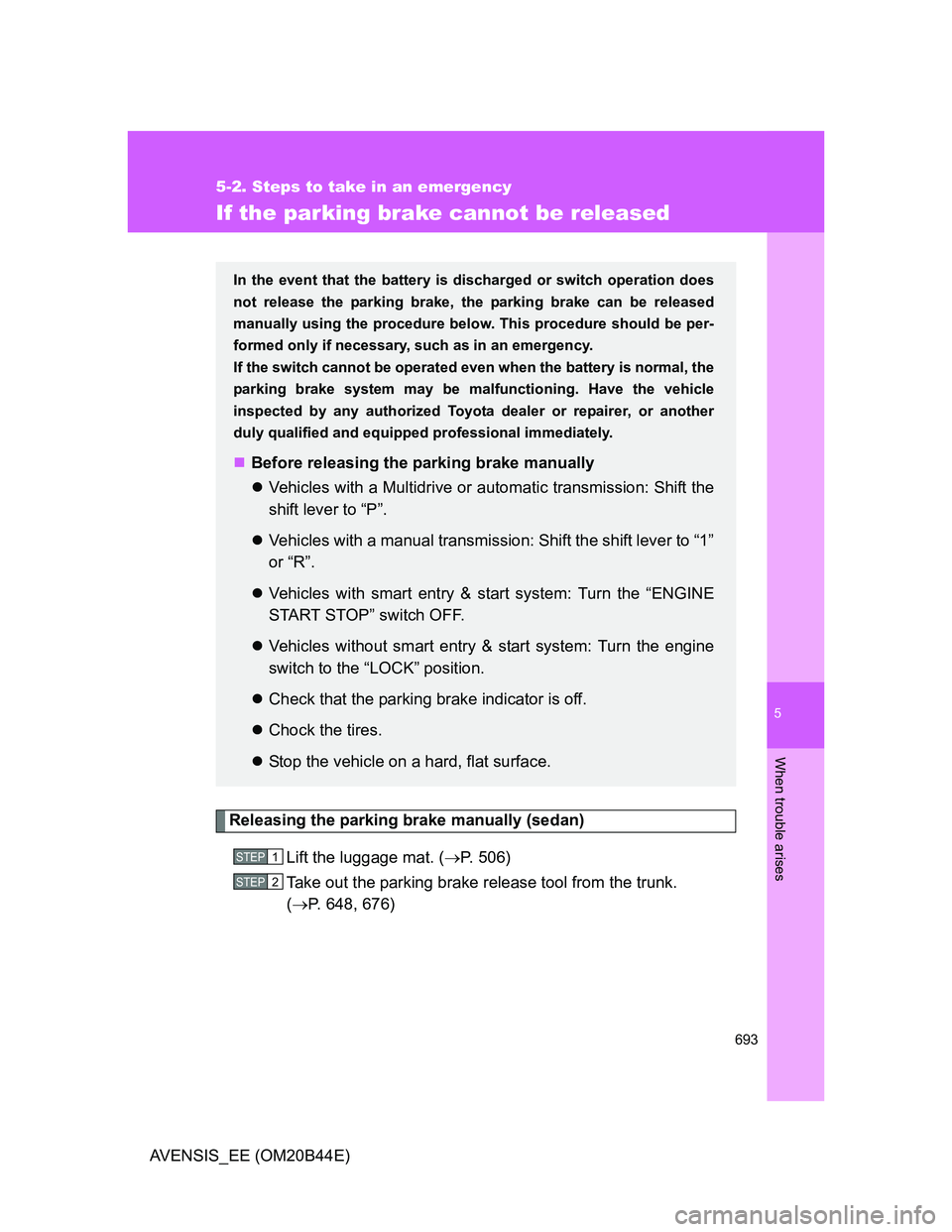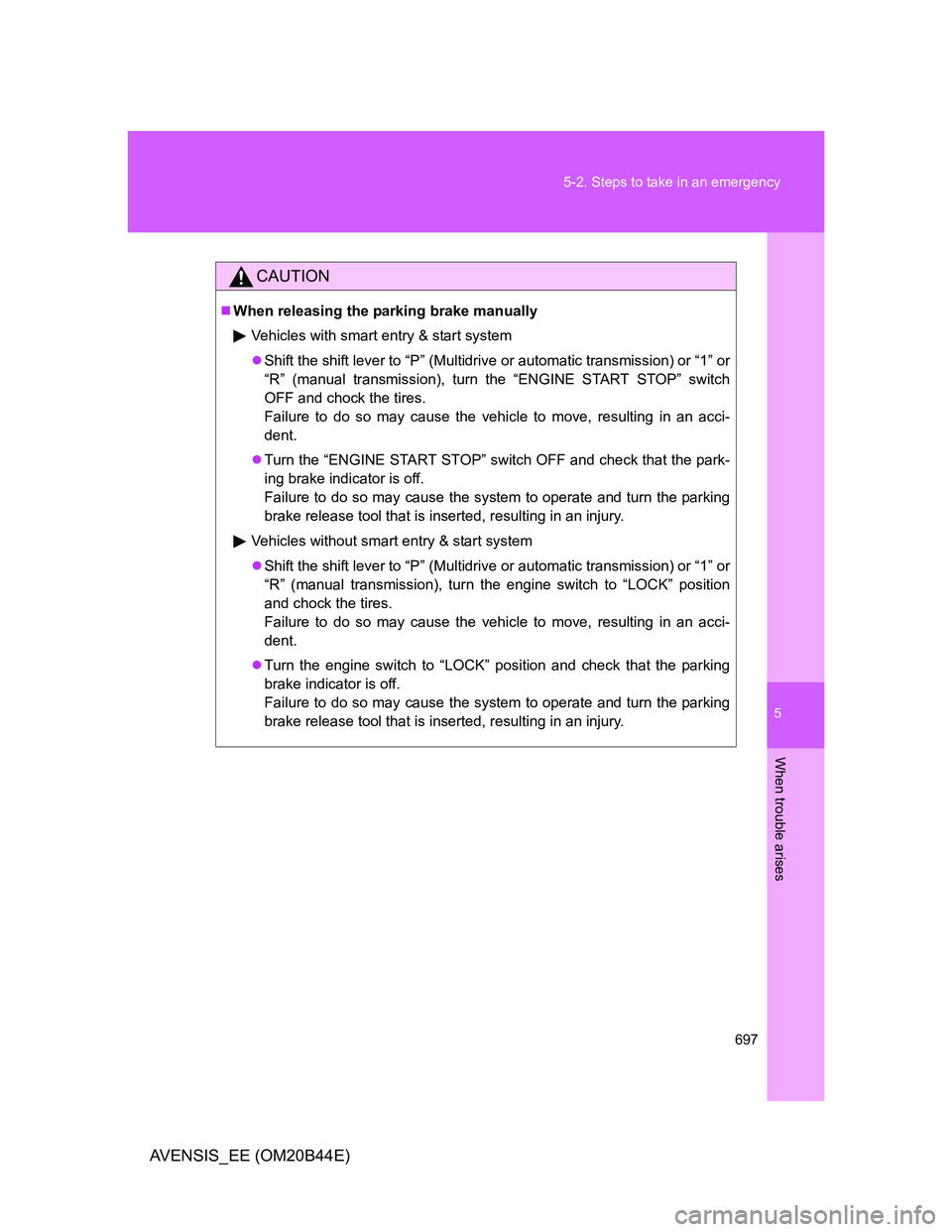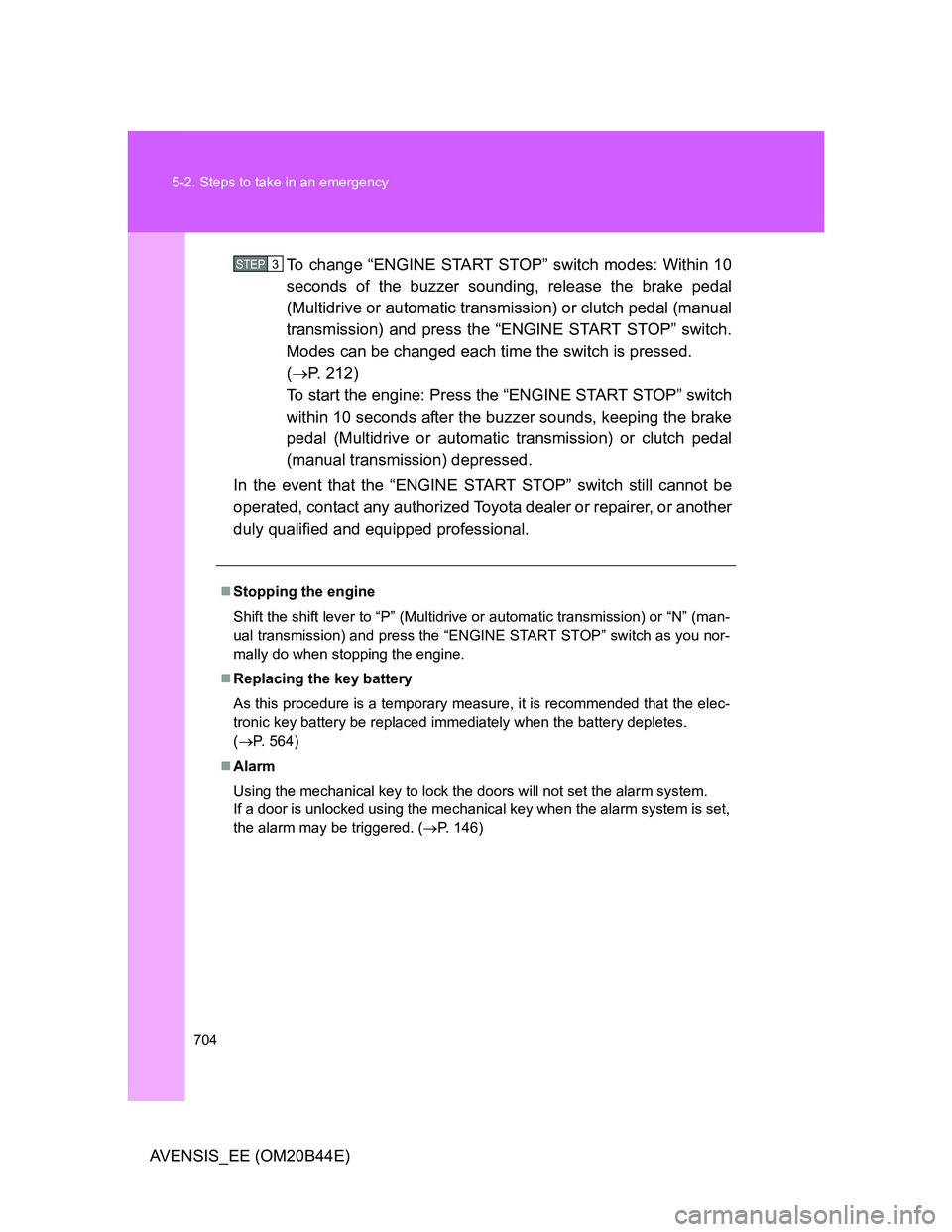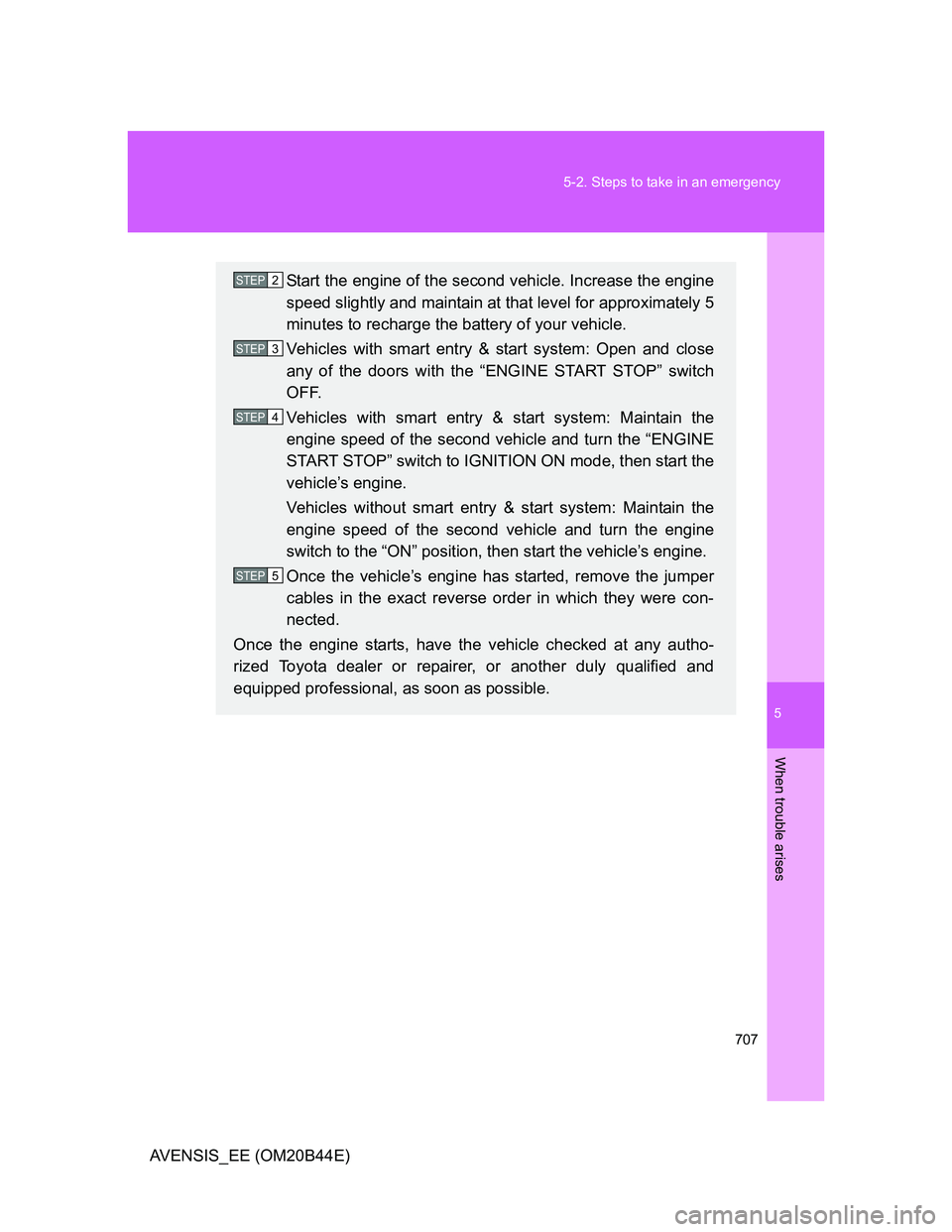Page 691 of 772
5
691 5-2. Steps to take in an emergency
When trouble arises
AVENSIS_EE (OM20B44E)
Emergency start function (Multidrive or automatic transmission
vehicles with smart entry & start system)
When the engine does not start, the following steps can be used as
an interim measure to start the engine if the “ENGINE START STOP”
switch is functioning normally.
Set the parking brake.
Put the shift lever in “P”.
Set the “ENGINE START STOP” switch to ACCESSORY
mode.
Push and hold the “ENGINE START STOP” switch about 15
seconds while depressing the brake pedal firmly.
Even if the engine can be started using the above steps, the system
may be malfunctioning. Have the vehicle checked by any authorized
Toyota dealer or repairer, or another duty qualified and equipped pro-
fessional.
STEP1
STEP2
STEP3
STEP4
Page 692 of 772
692
5-2. Steps to take in an emergency
AVENSIS_EE (OM20B44E)
If the shift lever cannot be shifted from “P”
For vehicles with Multidrive or automatic transmission: If the shift
lever cannot be shifted with your foot on the brake, there may be a
problem with the shift lock system (a system to prevent accidental
operation of the shift lever). Have the vehicle inspected by any
authorized Toyota dealer or repairer, or another duly qualified and
equipped professional, immediately.
The following steps may be used as an emergency measure to
ensure that the shift lever can be shifted.
Set the parking brake.
Vehicles with smart entry & start system: Turn the “ENGINE
START STOP” switch to ACCESSORY mode.
Vehicles without smart entry & start system: Turn the
engine switch to the “ACC” position.
Depress the brake pedal.
Press the “SHIFT LOCK” but-
ton.
The shift lever can be shifted
while the button is pressed.
STEP1
STEP2
STEP3
STEP4
Page 693 of 772

5
693
5-2. Steps to take in an emergency
When trouble arises
AVENSIS_EE (OM20B44E)
If the parking brake cannot be released
Releasing the parking brake manually (sedan)
Lift the luggage mat. (P. 506)
Take out the parking brake release tool from the trunk.
(P. 648, 676)
In the event that the battery is discharged or switch operation does
not release the parking brake, the parking brake can be released
manually using the procedure below. This procedure should be per-
formed only if necessary, such as in an emergency.
If the switch cannot be operated even when the battery is normal, the
parking brake system may be malfunctioning. Have the vehicle
inspected by any authorized Toyota dealer or repairer, or another
duly qualified and equipped professional immediately.
Before releasing the parking brake manually
Vehicles with a Multidrive or automatic transmission: Shift the
shift lever to “P”.
Vehicles with a manual transmission: Shift the shift lever to “1”
or “R”.
Vehicles with smart entry & start system: Turn the “ENGINE
START STOP” switch OFF.
Vehicles without smart entry & start system: Turn the engine
switch to the “LOCK” position.
Check that the parking brake indicator is off.
Chock the tires.
Stop the vehicle on a hard, flat surface.
STEP1
STEP2
Page 697 of 772

5
697 5-2. Steps to take in an emergency
When trouble arises
AVENSIS_EE (OM20B44E)
CAUTION
When releasing the parking brake manually
Vehicles with smart entry & start system
Shift the shift lever to “P” (Multidrive or automatic transmission) or “1” or
“R” (manual transmission), turn the “ENGINE START STOP” switch
OFF and chock the tires.
Failure to do so may cause the vehicle to move, resulting in an acci-
dent.
Turn the “ENGINE START STOP” switch OFF and check that the park-
ing brake indicator is off.
Failure to do so may cause the system to operate and turn the parking
brake release tool that is inserted, resulting in an injury.
Vehicles without smart entry & start system
Shift the shift lever to “P” (Multidrive or automatic transmission) or “1” or
“R” (manual transmission), turn the engine switch to “LOCK” position
and chock the tires.
Failure to do so may cause the vehicle to move, resulting in an acci-
dent.
Turn the engine switch to “LOCK” position and check that the parking
brake indicator is off.
Failure to do so may cause the system to operate and turn the parking
brake release tool that is inserted, resulting in an injury.
Page 703 of 772
5
703 5-2. Steps to take in an emergency
When trouble arises
AVENSIS_EE (OM20B44E)
Changing “ENGINE START STOP” switch modes and starting the
engine
Vehicles with a Multidrive or automatic transmission: Shift the
shift lever to “P” and apply the brakes.
Vehicles with a manual transmission: Shift the shift lever to
“N” and depress the clutch pedal.
Touch the Toyota emblem side of
the electronic key to the
“ENGINE START STOP” switch.
An alarm will sound to indicate
that the start function cannot
detect the electronic key that is
touched to the “ENGINE START
STOP” switch if any of the doors
is opened while the key is
touched to the switch.
STEP1
STEP2
Page 704 of 772

704 5-2. Steps to take in an emergency
AVENSIS_EE (OM20B44E)To change “ENGINE START STOP” switch modes: Within 10
seconds of the buzzer sounding, release the brake pedal
(Multidrive or automatic transmission) or clutch pedal (manual
transmission) and press the “ENGINE START STOP” switch.
Modes can be changed each time the switch is pressed.
(P. 212)
To start the engine: Press the “ENGINE START STOP” switch
within 10 seconds after the buzzer sounds, keeping the brake
pedal (Multidrive or automatic transmission) or clutch pedal
(manual transmission) depressed.
In the event that the “ENGINE START STOP” switch still cannot be
operated, contact any authorized Toyota dealer or repairer, or another
duly qualified and equipped professional.
Stopping the engine
Shift the shift lever to “P” (Multidrive or automatic transmission) or “N” (man-
ual transmission) and press the “ENGINE START STOP” switch as you nor-
mally do when stopping the engine.
Replacing the key battery
As this procedure is a temporary measure, it is recommended that the elec-
tronic key battery be replaced immediately when the battery depletes.
(P. 564)
Alarm
Using the mechanical key to lock the doors will not set the alarm system.
If a door is unlocked using the mechanical key when the alarm system is set,
the alarm may be triggered. (P. 146)
STEP3
Page 707 of 772

5
707 5-2. Steps to take in an emergency
When trouble arises
AVENSIS_EE (OM20B44E)
Start the engine of the second vehicle. Increase the engine
speed slightly and maintain at that level for approximately 5
minutes to recharge the battery of your vehicle.
Vehicles with smart entry & start system: Open and close
any of the doors with the “ENGINE START STOP” switch
OFF.
Vehicles with smart entry & start system: Maintain the
engine speed of the second vehicle and turn the “ENGINE
START STOP” switch to IGNITION ON mode, then start the
vehicle’s engine.
Vehicles without smart entry & start system: Maintain the
engine speed of the second vehicle and turn the engine
switch to the “ON” position, then start the vehicle’s engine.
Once the vehicle’s engine has started, remove the jumper
cables in the exact reverse order in which they were con-
nected.
Once the engine starts, have the vehicle checked at any autho-
rized Toyota dealer or repairer, or another duly qualified and
equipped professional, as soon as possible.STEP2
STEP3
STEP4
STEP5
Page 710 of 772
710
5-2. Steps to take in an emergency
AVENSIS_EE (OM20B44E)
If your vehicle overheats
If your engine overheats:
Stop the vehicle in a safe place and turn off the air condi-
tioning system.
Check to see if steam is coming out from under the hood.
If you see steam:
Stop the engine. Carefully lift the hood after the steam
subsides and then restart the engine.
If you do not see steam:
Leave the engine running and carefully lift the hood.
Check to see if the cooling fan is operating.
If the fan is operating:
Wait until the engine coolant temperature gauge begins
to fall and then stop the engine.
If the fan is not operating:
Stop the engine and call any authorized Toyota dealer or
repairer, or another duly qualified and equipped profes-
sional.
After the engine has cooled
down sufficiently, check the
engine coolant level and
inspect the radiator core (radi-
ator) for any leaks.
If the engine compartment
cover needs to be removed:
P. 537
STEP1
STEP2
STEP3
STEP4